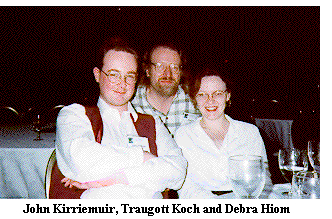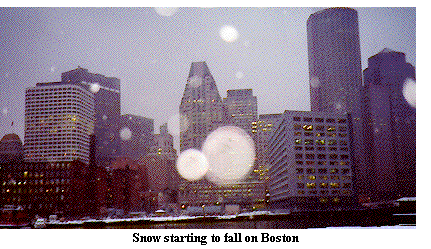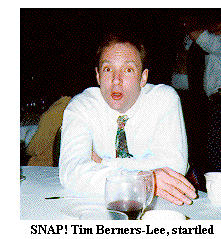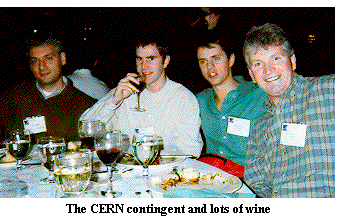The 4th WWW Conference in Boston
This is an informal diary of two delegates who attended the big event for World Wide Web people, namely the 4th International WWW Conference. Debra Hiom, the SOSIG research officer and John Kirriemuir, the UKOLN Information Officer provide the dialogue. The good quality photographs were taken by Debra, on her expensive camera, while the not-so-good quality pictures were taken by John on a cheap and nasty disposable camera (7 dollars).
Due to the rapid speed of change within the Web World, International WWW Conferences are held roughly every 6 months; number 3 in the series  was held in Germany in April 1995, while number 5 will be held in Paris in May 1996. This conference took place in the Copley Marriott Hotel in central Boston (where a large number of the delegates stayed) from December 11-14th.
was held in Germany in April 1995, while number 5 will be held in Paris in May 1996. This conference took place in the Copley Marriott Hotel in central Boston (where a large number of the delegates stayed) from December 11-14th.
The series of World Wide Web Conferences are the events to go to for sampling the latest in the rapidly moving field of World Wide Web development, research and implementation. This particular conference was hosted by the World Wide Web consortium (W3C), which now consists of over 100 member organisations and is headed by Tim Berners-Lee, the founder of the Web. At this particular conference, 57 papers were presented, as well as an exhibition of Web products and technology, a poster display of ongoing research, a day of tutorials and workshops and a day dedicated to developers of Web-based systems and technology. In addition, people were allowed to spontaneously set up their own "birds of a feather" session, where like-minded people could huddle and discuss their common interest. Selected sessions from the conference were broadcast over the MBONE, which enabled real-time sound and pictures to be relayed. This meant that people with an adequate network connection and the right software around the globe could watch the conference, as well as submit questions during the sessions.
The full programme is available on the Web, from which you can see the full versions of most of the presented papers.
Before the Conference - Saturday 9th and Sunday 10th
Getting there
Saturday the 9th of December and a trip to London to catch a plane. Before setting off, do a quick Web hunt for information on what to do if the plane crashes. Very frosty and crisp; hoping for some warmer weather in the States (should have checked where Boston was on the map first).
Flying across on Virgin Airways was a surreal experience. One of the inflight movies was "Babe", all about a pig that talks and herds sheep. Several people in the row in front start crying at the happy ending; the in-flight dinner of ham salad is subsequently declined by many passengers. With several alarming thuds, the plane touches down in Boston late-afternoon (eastern US time). Boston airport is peculiar in that it is situated only three miles from the City Centre. The approach involved flying over large tracts of American suburbia, intermingled with fog, low clouds and various combinations of rain/snow; disappointingly not that much different from home.
Baggage, customs and immigration was super-quick, so we were out of the airport less than half an hour after touching down. As we discovered later, several other of the UK delegation, who were due to arrive not long after us, suffered 12 hour delays due to the weather at Boston, most of it staring at a lonely runway from out of their plane at Washington airport.
The hotels and conference centre
Emerging from the airport reveals  colder, wetter and windier weather than that left behind in England. Due to the congestion at the bus to subway link, and a lack of faith in map reading, a taxi was requisitioned to speed us to our hotels. The taxi driver took a suspiciously circular route, twice passing the bar on which "Cheers" is based on.
colder, wetter and windier weather than that left behind in England. Due to the congestion at the bus to subway link, and a lack of faith in map reading, a taxi was requisitioned to speed us to our hotels. The taxi driver took a suspiciously circular route, twice passing the bar on which "Cheers" is based on.
The two official conference hotels were the Sheraton and the Copley Marriott, both huge (and expensive) complexes, connected (thankfully) by indoor walkways. Both hotels were luxurious, not really comparable to your average English conference hotel.
Most of the conference was due to take place in the Marriott, which had dozens of session/function rooms of differing sizes, the largest of which could comfortably hold 3000 people. Exploration of the connecting walkways revealed the inevitable shopping mall, as well as the Hynes Convention Centre, a large building of mainly huge, empty rooms (reminding one of the film Brazil), where the remaining sessions were to be held.
Registration
On the Sunday, the shutters were opened and registration began. Delegates were handed a large and very smart shoulder bag, containing:
- A sweatshirt, with the conference picture on the front and (inevitably) the URL for the conference Web pages on the reverse
- A ticket for a conference mug, which it turned out was of tankard capacity with weight to match
- A conference poster. Requests for a swap for an Oasis poster inevitably caused some puzzlement.
- The "World Wide Web Journal", which consisted of the conference proceedings (all 740 pages of it)
- Proceedings of the tutorials, posters and workshops
- Attendees list
Perusal of the attendees list made for some slightly depressing reading. Out of the approximately 2300 delegates listed, only 63 were from the UK. Other European countries were also represented with few attendees; 61 came from France (most of those from 1 organisation), 30 from Italy, 4 from Spain and 2 from Ireland. Somewhat inevitably, out of the 10 pages of delegates, USA attendees filled over 7.
Monday 11th - Tutorials and Workshops
Monday dawned, and with it a day of tutorials and workshops. Delegates had to nominate their first three choices of these sessions via email some weeks previously, so this was a day without deliberating over what session to attend.
Designing and Maintaining a highly Usable Site
This half day tutorial was run by Jakob Nielsen of Sun Microsystems, and gave an overview of the design decisions behind the public and the internal Web server systems created and maintained by Sun Microsystems. Initial worry that this would be half a day on someone telling us why Sun's Web site/Sun itself was so great proved to be unfounded, and a lot of reasoned Web design strategies were discussed in the session.
Jakob gave a summary of the analysis of the use of Sun's public Web site. Some of the many points of interest were:
- People used a considerable number of different browsers to look at the Sun site. For each of these browsers, significant numbers of people used different versions; several versions of Netscape and Mosaic, for example, were used in the same time interval by large numbers of people.
- It became evident that if the pages linked from the home page were not as impressive/stylish as the home page, then people were put off, or spent less time, looking at those pages (no matter what their content).
- Simple changes to the look and interactiveness of the pages had a dramatic effect on how people navigated through the Web site. For example, when the "What's new" button was moved to a more prominent position on the main page, it resulted in a 416% increase in the number of people who used it.
- Users were often reluctant to scroll; links to other pages at the bottom of a page were usually traversed less than those at the top of the page. Evaluation of how users "read" the Web pages showed that many of them were reluctant to "read" in the conventional sense, preferring to home in on links (and the surrounding text) to other pages.
A summary of some of the considerable log analysis was given, showing the changing patterns in the geographic distribution of users, how the pages were browsed, access growth rates.
One aspect of the design criteria that was stressed several times during the morning was the desirability of "directing" browsers to the Web pages they would most likely want to go to, rather than just presenting them with a long list of linked items on the Web site.
(Trying to) email home
In the afternoon and evening, the on-line rooms were opened to conference delegates. The two rooms consisted of some 80 PCs and Macs.  All the computers allowed telnet access so you could (remotely) read and send email from your account back home. Inevitably, all of the computers also allowed Web access, with most having Mosaic and Netscape mounted. Having said that, it was noted that as the conference progressed, an assortment of browsers gradually appeared on many of the machines, probably downloaded and set up by delegates who did not use Netscape/Mosaic as a first choice browser.
All the computers allowed telnet access so you could (remotely) read and send email from your account back home. Inevitably, all of the computers also allowed Web access, with most having Mosaic and Netscape mounted. Having said that, it was noted that as the conference progressed, an assortment of browsers gradually appeared on many of the machines, probably downloaded and set up by delegates who did not use Netscape/Mosaic as a first choice browser.
The first big disappointment of the conference came when trying to make a telnet connection back home, to read/write email. Connecting before late afternoon to the UK was impractical; even in the early/mid evening, characters crawled slowly across the telnet interface, frequently freezing for several minutes at a time. Frustration was further fuelled by seeing people from other European countries, such as Sweden, France and Italy, typing away more or less in real time. Web access to the UK was also very slow; in the time it took to access the home page of a Manchester university, a group of Swedish delegates at the adjoining PC managed to explore all of the Volvo Web site.
The one advantage of the relatively slow connection to the UK was that it was easy to spot other UK delegates in the on-line rooms; they were usually the frustrated delegates apparently not doing anything :-)
Tuesday 12th - Papers (Day 1)
Tuesday marked the first day proper of the conference. Breakfast in the conference area started at 7:30 am; 8:25 saw several of the British delegation shuffle in to a near-empty self-service area, mistakenly thinking that most people hadn't yet got out of bed. As it later emerged, many of the US delegates had been queuing for food since before 7:30, and had now bagged the best seats for the opening plenary session. Made mental note to in future appreciate the reasurringly late times that conferences in the UK generally start.
The Opening Sessions
The opening session got off to a bad start with several of the key people not being there, and Tim Berners-Lee apparently stuck in traffic, causing repeated apologies from the conference opener. Soon, we were into Bran Ferrens keynote address.
Bran works for Disney; despite their reputation for being draconian with anyone using anything even slightly Disney-like in their Web pages, he appeared to be quite a cheerful and fair character, greatly resembling Grizzly Adams in appearance. Bran gave a potted history of technological breakthroughs, showing how the wrong person usually got the credit for inventions. This went on for so long that most people forgot the point he was trying to make (but it was at least entertaining). He described the Web as being like "a project commisioned by the Institute of the aesthetically challenged". Unfortunately, there was little else of relevance in his address, entertaining a speaker though he was.
Resource Discovery
IAFA Templates
Dave Beckett from the HENSA Unix Archive presented a paper on IAFA templates in use as Internet Metadata. Beckett is using IAFA templates to index an Internet Parallel Computing Archive at the University of Kent. The archive is a mixture of resources including reports, software, documentation, bibliographies, etc. Originally chose IAFA templates (1993) as they allowed for a much richer range of metadata to be created than other existing standards, e.g. Linux Software Maps. Even so had to create new template types and attributes (field names) to accommodate the different resources in the archive. There is some automatic extraction of metadata from the resources, for example the format of the resource can often be gleaned by looking at the filename extensions e.g. .ps (postscript). However also added hand-written metadata such as descriptions to the templates. Problems encountered using IAFA were difficulties in representing nested metadata and the use of non-ascii characters within the templates. Some future work Beckett set out was to have user configurable views of the templates and provide a URC service based on the templates.
At a later URC bof Dirk Van Gulik presented some information about the European Wide Service Exchange (EWSE). This is a directory service for people, products and services concerned with the application of Earth Observation data. The data is stored in IAFA templates and they are using a harvester to find information. Van Gulik was also interested in providing a URC resolver service.
URI Panel
A panel of the great and the good were brought together to discuss URIs (Uniform Resource Indentifiers). Chaired by Stuart Weibel from the OCLC Office of Research each speaker was given roughly 5 minutes to put forward his/her position on what they thought were the most important issues in this area. This was obviously too short a time for any real discussion to take place but the the overall impression was that URNs and URCs were still a long way from being settled. Some comments from the speakers:
Larry Masinter from XEROX PARC thought that the problem with URLs is not so much that URLs change but that 'stuff goes away'. A naming system won't solve this problem and the preservation of online material is an issue that needs to be addressed.
Karen Sollins from MIT Laboratory for Computer Science put forward a list of characteristics that were required of URNs. They will need to have:
- longevity
- mobility
- potential to evolve
- ubiquity
- global participation
Ron Daniel from LANL put forward a scenario for a hiearchical scheme where the client (browser) would first check the local cache for the resource, if this was not sucessful the client would contact a local resolving registry and the local resolver would in turn contact an outside registry.
Five years on - Tim Berners-Lee speaks
The last session in the afternoon was an hour of Tim Berners-Lee speaking about the  evolution of the Web, and what he would like to see in the future. This was probably the most heavily attended session of the conference, and certainly the one with the largest press and TV contingent.
evolution of the Web, and what he would like to see in the future. This was probably the most heavily attended session of the conference, and certainly the one with the largest press and TV contingent.
The section on the early days of the Web were most interesting. Tim preferred HTML before inlined images were introduced (into Mosaic), as it made people more literate. He also noted how the concept of the "home page" had changed. In the early, dark days of the Web (before 1994), the home page was the page where you started to browse around the Web. Since, then, and partially helped by bookmarks being a fundamental feature of most browsers, the home page was now someones the self-publicity Web area.
This presentation produced, for many people, the highlight of the conference. About halfway through, while he was using a demo version of a browser to view his Web pages, the browser licence expired, with an accompanying message on the screen. The ironic situation of the founder of the Web, being unable to access Web pages because of a commercial/licencing software problem, struck home with many people. Several heavily bearded and sandalled delegates in front of us, who appeared to closely resemble stereotypical techno-hippies, commented "like, symbolic, Man...".
The banquet and socialising
In the evening, a banquet was held in the Marriott Hotel for  all of the delegates and what appeared to be several dozen hotel employees. The food was okay, so long as you weren't vegetarian; meals at the conference tended to have a vegetable/fruit based starter, and if you did not eat meat, you generally got the same again (but as a bigger portion) for the main course. However, several bottles of wine on each table (most of ours drunk very quickly by 4 CERN employees) and the chance to talk to lots of people on things Web made up for this. The music was provided by an odd jazz combination, the lead singer of which tried (and failed) to get into the "mood" by singing lines like "found myself a URL" and "got myself my Web page". Hmmmm.
all of the delegates and what appeared to be several dozen hotel employees. The food was okay, so long as you weren't vegetarian; meals at the conference tended to have a vegetable/fruit based starter, and if you did not eat meat, you generally got the same again (but as a bigger portion) for the main course. However, several bottles of wine on each table (most of ours drunk very quickly by 4 CERN employees) and the chance to talk to lots of people on things Web made up for this. The music was provided by an odd jazz combination, the lead singer of which tried (and failed) to get into the "mood" by singing lines like "found myself a URL" and "got myself my Web page". Hmmmm.
Wednesday 13th - Papers (Day 2)
Wednesday marked the second day of papers and, soon though it seemed, the closing session. As with yesterday, the day started with Birds of a Feather sessions in the (very) early morning, followed by multiple parallel sessions of papers throughout the day.
Closing the conference
The main wrap up keynote speech was by Robert Metcalfe, the Vice President of Advanced Technology. Though heavily opinionated and somewhat lacking in real substance, this was quite entertaining; the speech was basically a collection of soundbites, including:
- "The percentage of people in the World who use the Web rounds to zero"
- "The least important subject covered at the conference was creating cool Web pages using HTML" [did think of pointing out that attractive, useful Web sites would make more people use the Web, and help move the aforementioned percentage above zero]
- Robert wasn't sure what the most important subject covered, but then later said "Java is the biggest thing to happen since the PC"
- "The Web is self-policing - whevever I get near any pornography, the traffic keeps me out"
Robert spent some time predicting that the Web would "collapse" or "enter a dark age" in 1996, but wouldn't say specificially what he believed such an event would occur of.
Thursday 14th - Developers Day
Thursday was developers day. Despite the conference "officially" ending the day before, many people were still around for the various sessions aimed at people developing software, systems and standards. As the sessions for this day had sold out some time previously, there were a noticeable number of people slipping into the sessions wearing dubious badges and identification. Most delegates attention was also distracted by the heavy snowfalls that started during the morning, and got worse throughout the day. A noticeable degree of concern about getting home became evident when one of the afternoon speakers didn't appear for some time as his incoming flight was snowbound.
Getting home - Thursday, Friday and Saturday :-(
John - Straight after the conference, caught a packed subway train to the airport with a bad feeling about getting home. At the airport, the driver on the subway to airport connecting shuttle bus cheerfully informed us that he expected the airport to shut at any minute. Uncannily, he proved right - the minute I made it to the checkout desk. The airport closed for four hours while snow was cleared. While this was happening, the plane I was due to get out on was stranded further west. This came in five hours late, emptied it's intake of passengers and promptly suffered "slight engine problems". At 2:30am (6.5 hours after expected takeoff), the engine problem was deemed to be "serious".
One mad scramble to the checking in desk ensued, followed by painfully slow allocation onto flights on other airlines leaving in the morning and a hotel room for what was left of the night. 4am sees arrival at hotel; 5:30am sees departure from hotel back to airport. Three hours of checking in later, all ready to board new plane, which promptly suffers from "pilot stranded in slush" problem. Take off two hours late; arrive back in England, at a different airport to my scheduled one, 17 hours late.
Debra - I had arranged to extend my stay for another 3 days to get a chance to explore Boston. This I did in sub zero temperatures and despite the odd bit of frostbite was very glad that I had stayed on. Especially as by this time most of the snow had gone and I (very smugly) had a trouble free flight home. After Robert came a plug for the 5th WWW Conference, whose official slogan appears to be "Paris in the spring". It seemed a bit bizarre, with the conference only officially beginning 32 hours before, for it to be closing with details of the next one.
